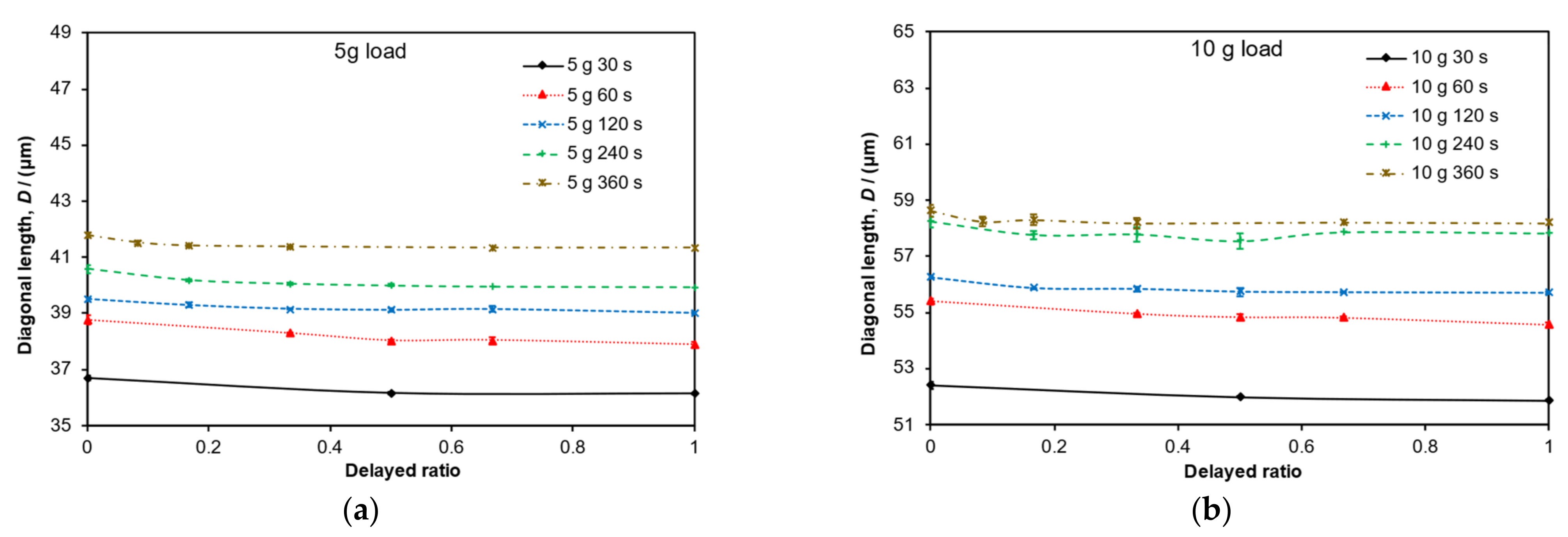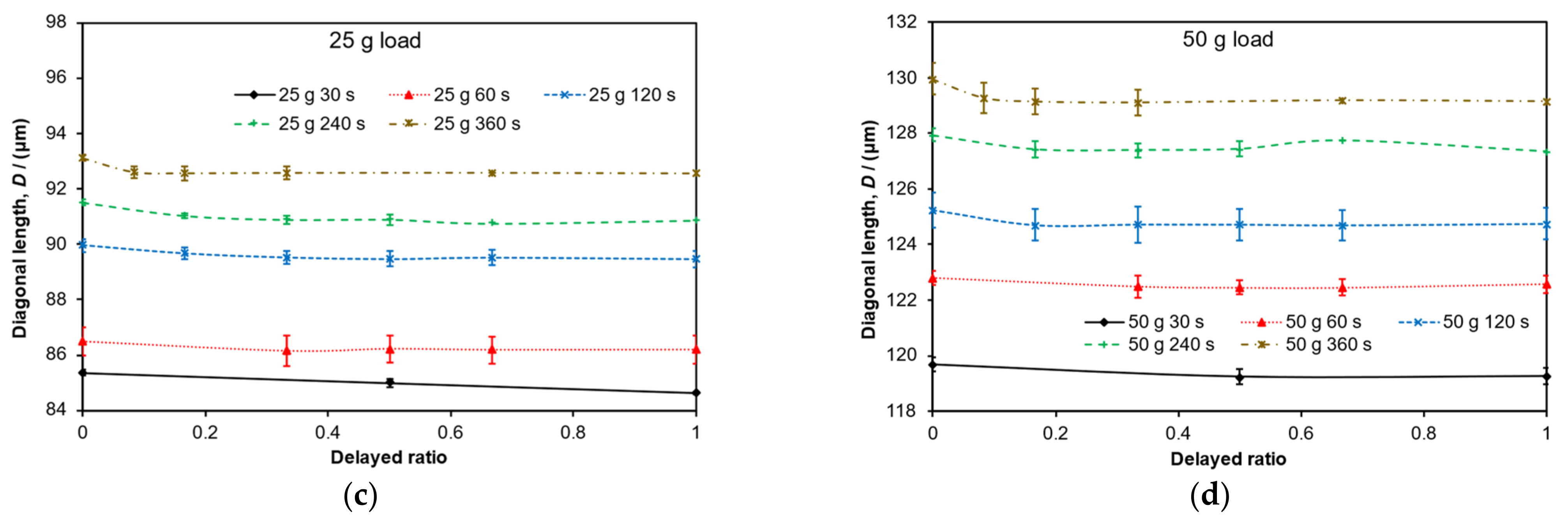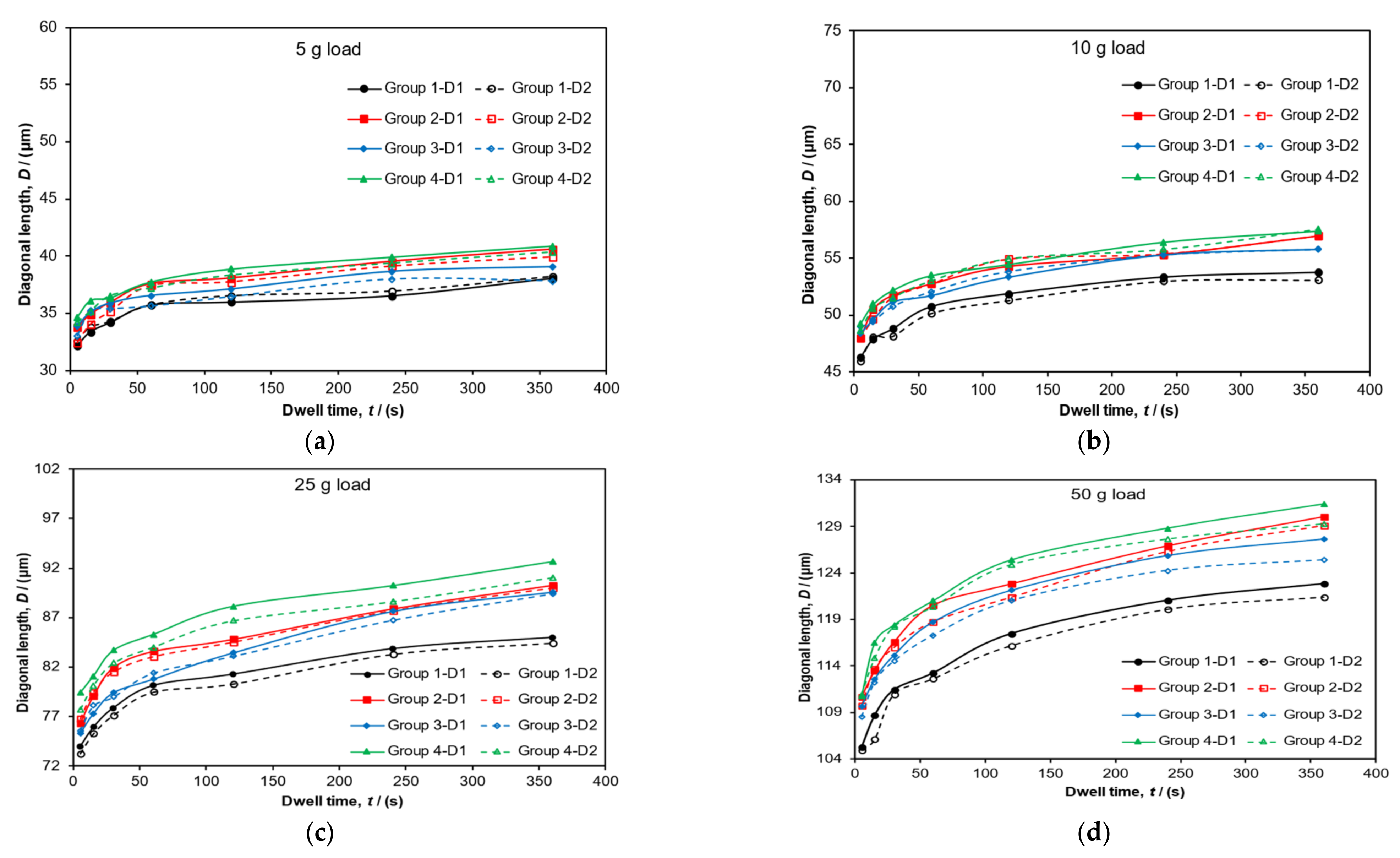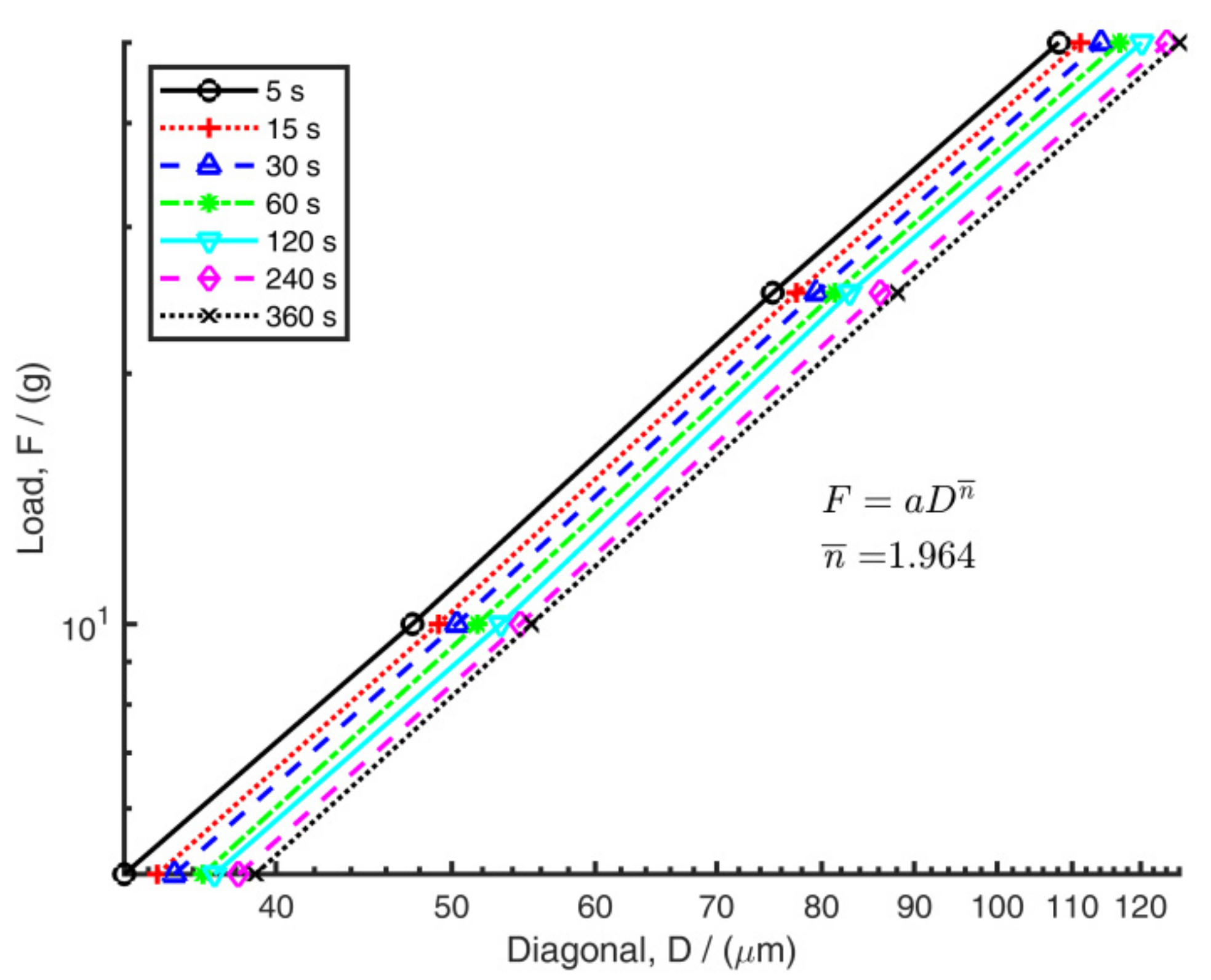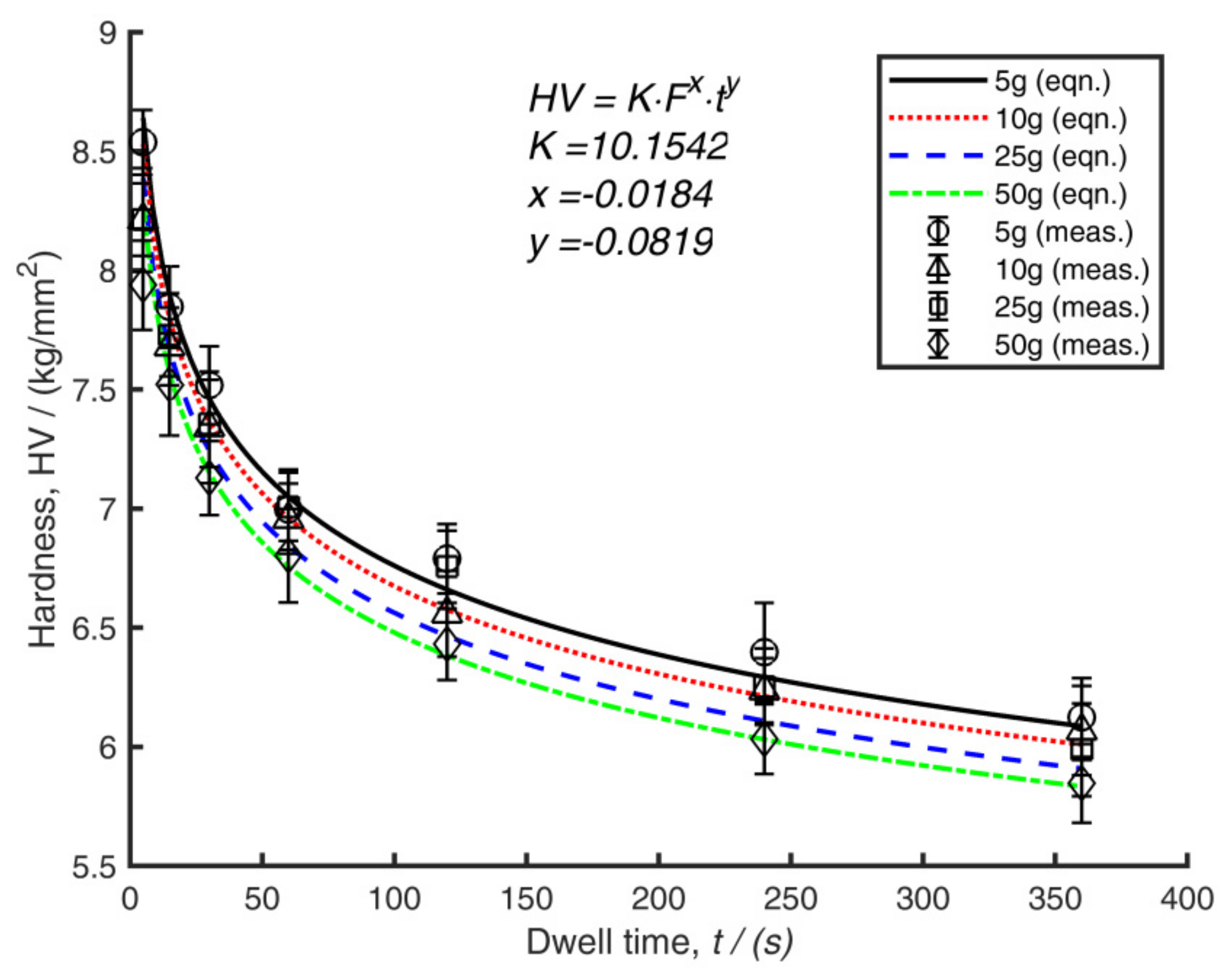1. Introduction
Hardness testing, defined as a test method to measure a material’s resistance to permanent indentation, was developed for metals but can be applied to polymers even though they exhibit a viscoelastic response that complicates the analysis [
1,
2]. However, it is only after appropriate calibration and parameter selection that hardness testing can be recommended for the measurement of permanent deformation of a polymer’s response to indentation [
3].
Different types of hardness testing are available that can be classified against two basic defining aspects, namely, the loading procedure and the indenter geometry. Lopez [
1] and Baltá Calleja [
2] provide literature reviews of the common hardness testing methods used in polymer science. Hence, hardness numbers are specific to the hardness test method and indenter used. For metals, hardness numbers from different test methods are cross-referenced for equivalence against dedicated hardness scales [
4]. On the other hand, due to their viscoelastic response and temperature response, defining equivalence between hardness scales for polymers is more complicated. Any attempt to cross reference polymer hardness numbers between scales is discouraged.
The first characteristic to consider in hardness testing is the loading-unloading procedure as this has a direct bearing on whether the measurement can be recorded ex situ (measured by inspection after the indenter is removed) or in situ (with the loaded indenter in place).
Typically, for ex situ measurement, the indenter is applied to the surface of the material until a target load is established and held constant for a prescribed time known as dwell time. The indenter is removed, and characteristic measurements are taken from the impression imparted on the surface. Generally, with this load-on, load-off procedure, the hardness number is obtained by dividing the load (kg) by the surface area of the impression (mm2). The surface area of the indent is estimated using the indenter geometry that made the indent.
In situ measurement of hardness is a rapid test procedure. In this case, the indenter is presented to the surface of the test specimen, and a minor load is applied to engage the point of the tool with the surface. Subsequently, a major load is applied for a specified time and the distance travelled, i.e., the depth achieved by the indenter into the material is the main measurement taken with the minor load reapplied. Typically, with this minor-major loading procedure, the hardness number is obtained from the distance travelled into the surface (i.e., the penetration depth) applied to the Rockwell equation for hardness.
As mentioned, the second characteristic for hardness testing is given by the geometry of the indenter. Brinell hardness testing, for example, uses a spherical indenter with a load-on, load-off procedure. One of the disadvantages of Brinell hardness testing arises due to the non-linear relationship between the area of the impression and the penetration depth; hence, to obtain reliable hardness values the impression diameter needs to be less than half and greater than a quarter of the indenter diameter. Vickers hardness testing uses a pyramidal indenter and a load-on, load-off procedure, which gives geometrically similar impressions regardless of the penetration depth. Two characteristic lengths are measured on the Vickers indent, the indent diagonals, and an average diagonal length is used to calculate the impression area. Load divided by area gives a Vickers hardness number. Knoop hardness testing is similar to Vickers, except that it uses an elongated pyramidal indenter. Rockwell hardness testing, on the other hand, uses the minor–major loading procedure and in situ measurement of depth. Two different indenter geometries are used in Rockwell testing: spherical and conical (also known as a Brale indenter). The Rockwell testing procedure is generally preferred for high volume production scenarios because it can give results more speedily than Vickers, Knoop or Brinell. For polymers testing, Rockwell test designations HRR, HRL, HRM, HRE and HRK (all using ball indenters) are applicable (ASTM D785 [
5] and ISO2039-2 [
6]). However, Rockwell testing is preferred for hard plastics where the results are less likely to be rate dependent.
A Barcol hardness (ASTM D2583 [
7]) test is also suitable for rigid polymers (reinforced or otherwise). For softer polymers and elastomers, Shore hardness (ASTM D2240 [
8]) (or Durometer hardness testing) is typical. An indenter is pressed into the material, and a reading is taken within a second of firm contact with the specimen. The hardness numbers read off instantly and are then referenced against a scale. Scales Shore A and Shore D are common with Shore A being used for softer polymers. The Barcol and Shore hardness tests are rapid methods useful for quality assurance purposes. They are not suitable for precision scientific work due to measurement uncertainties associated with manual operation.
A further distinction given on the Vickers test is known as micro Vickers hardness testing. In this case, the indenter load is kept below 2 kg, and generally, the diagonals are measured using an optical microscope due to the small length scales involved. Micro Vickers testing gives hardness at precise locations and is therefore used frequently in scientific laboratories. Because the indents are measured at the microscale, sample preparation, involving grinding and polishing, must be used, as standard, prior to the indentation in order to achieve reliable results.
Due to their viscoelastic response, polymers are also tested using the Wallace hardness procedure. The Wallace test uses a Vickers indenter but with a minor-major loading procedure. The travel distance of the indenter is monitored and recorded continuously even after the major load is removed to give deflection versus time and the viscoelastic response during load and recovery. Penetration depth is the measured quantity; however, indenter geometry is used to estimate the diagonal length of the impression used in the standard Vickers hardness equation (introduced in the next section) to give a hardness number. Although the Vickers indenter and the Vickers equation are used in the Wallace test, care should be taken not to equate a peak Wallace hardness number directly with a traditional Vickers hardness test number. The loading and measurement procedures are very different, and this means that classic Vickers testing cannot capture load recovery information to the same extent that the Wallace test can. This feature was highlighted by Suwanprateeb [
9] who presented hardness data comparing diagonal length (ex situ) versus penetration depth (in situ) measurement methods for HDPE and PMMA polymers. Differences in the calculated Vickers hardness numbers between the alternative methods were as high as 60% at 1 kg load and dwell times of 1 s. The differences between the hardness calculations between methods became insignificant as the load was increased to 5 kg for PMMA and 2 kg for HDPE. In addition, the in situ depth penetration displayed a load dependence as well as a dwell time dependence. Correspondingly, the ex situ diagonal length measurement method for hardness showed time dependence only, that is, the hardness measured as a function of diagonal length was load independent. Overall, the data presented in Reference [
9] highlights the challenge faced when using hardness as an absolute measure of a material property, especially. Similarly, Parashar et al. [
10] studied the relationships between the different load levels (varied from 5 g to 160 g) and the Vickers hardness of PETP, PTFE and PP. They used a fixed dwell time of 30 s throughout. The results showed that the hardness measurements of PP sharply increased from 5 g to 10 g and remained at stable levels as the loads were over 20 g. The behaviour at very low loads was attributed to the depth of the indenter being comparable to the depth of the distortion zone where any further loading would cause intense slipping of polymer chains. Hardness in polymers is highly dependent on test parameters selection, and this prohibits casual cross referencing of hardness numbers not just between different hardness scales but even within the Vickers scale itself. Vickers hardness numbers in polymers need to be cited along with the load level, the dwell time and the measurement method (i.e., penetration depth or diagonal length).
Crawford [
3] performed a dedicated study of microhardness testing, whereby Wallace testing was compared with traditional Vickers testing. After the differences were highlighted, Crawford showed that, with a careful selection of test parameters, meaningful and repeatable hardness data can be acquired from the traditional Vickers test even though the polymers tested displayed viscoelastic responses. It was discovered that once the indenter is removed the depth recovers significantly (by 50–70%) because of the viscoelastic response. Importantly, however, the corresponding recovery on the diagonals was less than 5% [
3]. This latter point of low recovery of the diagonals makes traditional hardness testing feasible for polymers.
Another hardness measurement approach is called Depth Sensing Indentation (DSI) or nanoindentation, which uses a Berkovich indenter and the Oliver–Pharr load–unload method to give hardness and modulus [
11]. Although its application to polymers is somewhat controversial, Giró-Paloma et al. [
12] provided a framework for DSI applied to polymers. However, this work focuses on the suitability of micro Vickers hardness of isotactic polypropylene (iPP) and offers a framework for comparing hardness data reported in the literature that used alternative testing parameters. Polypropylene is a semi-crystalline polymer where the degree of crystallinity is dependent on parameters such as tacticity, fillers type, concentration and processing conditions. Isotactic polypropylene is polymorphic and can have three crystalline modifications including: α, β and γ forms. Isotactic polypropylene crystallizes into α-form under traditional processing conditions; β-modification is formed under special processing conditions or in the presence of nucleating agents, and γ modification is found in low-molecular weight iPP and random copolymer polypropylene [
13,
14]. Both the degree of crystallinity and the proportion of the crystalline modifications affect mechanical properties. Martinez Salazar et al. [
15] investigated Polyethylene (PE)-polypropylene (PP) blends via microhardness testing but in so doing needed to characterise the microhardness of PP independently from PE. They showed that an additive law described based on crystallinity was suitable to describe the microhardness of PP as follows:
where α is the percentage crystallinity;
HC is the hardness of fully crystalline PP, and
HA is the hardness of fully amorphous PP. Using hardness testing with loads of 0.25 and 0.5 N and with a loading cycle of 0.1 min, Martinez Salazar et al. were able to extrapolate to show
HC = 30 MPa and
HA = 116 MPa. Whereas, this is useful information, there is ambiguity with regards to the hardness testing parameters. It was not clear which load was used consistently (i.e., 0.25 or 0.5 N). Furthermore, the cycle time was 0.1 min or 6 s. Crawford’s work shows that hardness values are strongly dependent on dwell time; therefore, great caution must be exercised when cross referencing the hardness data in Reference [
15] against hardness data obtained over longer dwell periods (as recommended by Crawford).
A clear example of the difficulty in cross referencing hardness data from different sources was outlined by Flores et al. [
16]. They investigated the microhardness of polymer-carbon black (CB) composites at different levels of CB addition. They cited data from Koszkul [
17] who provided hardness data on the effect of CB addition into iPP, but the starting data, i.e., iPP without CB addition, showed microhardness of 29 MPa with α of around 0.5. This value was seen as too low and could not have been reconciled with the data presented in other sources since no dwell period for the hardness test was cited in the original information source. Hence, the difficulty with cross referencing hardness data without full knowledge of the testing parameters was demonstrated. Seidler and Koch [
18] investigated the relationship between different heat treatment temperatures and the Vickers hardness of α- and β-crystalline phases iPP. They also reported different creep tendencies and elastic moduli of the two types of iPP using Depth Sensing Indentation (DSI) or nanoindentation. However, this study only chose a single set of testing parameters with a load of 1 g and a dwell time of 30 s for Vickers hardness testing.
In order to analyse polymers for hardness testing, much care and attention must be given to the sample preparation using typical mounting and polishing procedures. However, there is little detail of sample preparation found in the literature, which represents a significant gap. The determination of the testing procedure (including sample preparation) and parameters is of paramount importance so that meaningful results can be determined.
The aim of this study is to determine the suitability of micro Vickers hardness testing to iPP. In particular, the research question is what empirical and mathematical framework, if any, must be adopted to allow for comparisons to be made between different hardness datasets obtained under different test parameters? The study will investigate the appropriate steps to take in terms of sample preparation, so that repeatable and reliable results can be achieved. Detailed objectives include:
Investigation of mounting iPP samples in other cold-casting polymers such that the curing temperature is kept below 25 °C.
Establishment of suitable grinding and polishing processes for mounted iPP samples.
Investigation of the relationship between hardness and dwell time at different load levels and, through data fitting, finding empirical data for iPP regression equations.
Development and validation of hardness protocols for isotactic polymer at low load levels between 5 and 50 g.
The relevance of the final objective is made clear by considering that lower load levels lead to smaller indents with smaller diagonals (less than 150 µm). Many modern Vickers hardness testers are limited in the size of indent that they can measure (indents on metals are typically less than 150 µm); hence, lower loads facilitate the usage of a greater number of modern hardness testers. However, this work avoids the very low load (<5 g) regimes shown by Parashar et al. [
10] where hardness increases at a high rate with load increase due to the indenter depth being comparable to the size of the distortion zone. In the proposed experimental loading regime, it is expected that the indenter depth will penetrate to levels where the effect of the distortion zone in advanced of the indenter diminishes because the penetration depth is larger than the extent of the distortion zone itself (according to ref. [
10]).
Finally, to demonstrate the applicability of the hardness testing method, a series of tests will be performed on iPP with varying wt.% of CB. The purpose of testing with carbon black addition is to demonstrate hardness testing as a comparative, heuristic test method suitable for quality control.
4. Discussion
As Crawford [
3] rightly points out, the term hardness is somewhat ‘indefinite’, and a hardness number cannot be considered as a fundamental property of matter. Because the term hardness only takes on significant meaning when the precise test method is established, hardness numbers need to be used with due care. Hardness is typically a function of other material properties, such as modulus, yield strength, Poisson’s ratio, etc. However, as shown in this analysis, hardness values for polymers are also highly dependent on the parameter set chosen. It was shown that the calculated hardness reduced as the dwell time increased (
Figure 9), but this did not necessarily mean that the material became softer due to the action of the longer dwell times; instead, the viscoelastic response of the material affected the hardness reading due to longer indentation application timings. Therefore, it has been shown that the specific test parameters, namely, load and dwell time need to be considered carefully and quoted when providing the hardness numbers.
As shown by Crawford [
3], a fitting curve in the form of Equation (5) can be applied to predict the response of the hardness values to loads and dwell times.
Table 1 compares the values for iPP that were discovered in this research versus the values provided by Crawford. It can be seen that the parameters derived through the current analysis differ significantly from those provided in the literature. It is expected that the fitting parameters presented for each case depend on the condition of the material. Therefore, it should be expected that the information presented in
Table 1 is dependent on the crystallinity or microstructure of that particular sample. Therefore, again, caution should be exercised when gathering data across different samples. Since, in this case, all data in
Figure 9 were taken from samples processed under the same conditions (i.e., the sample is the same), it is safe to assume that the crystallinity was consistent in the current case.
The crystallinity is estimated by rearranging the additivity law (Equation (1)) to give:
In order to use this law, the hardness values have to be measured using consistent hardness test parameters. Martinez Salazar et al. [
15] measured hardness over 6 s using two loads: 0.25 and 0.5 N. Using this input information along with data from
Table 1, the estimated hardness is 81 MPa at a load of 0.25 N and is 80 MPa at a load of 0.5 N (i.e., assuming a dwell time of 6 s). Based on the data for
HC and
HA from Reference [
15], the crystallinity is therefore estimated to be within the range of 58% to 59%. The narrow range demonstrated in this estimated result (1% difference after a doubling of load parameter) is due to the low load dependency of hardness in this test range (as clearly shown in
Figure 6b). The average crystallinity of the sample was confirmed using Differential Scanning Calorimetry (DSC) to be 36.44%. Hence, the estimation approach used here is an overestimate of the crystallinity measured directly by an accepted method. Crystallinity gradients are known to occur in rapidly cooled, relatively thick samples due to differences in cooling rate across the sample. The hardness measurements were all taken along the centreline of the sample, where the cooling rate is expected to be the lowest. Lower cooling rates would lead to higher crystallinity in the centre of the sample.
The application of hardness testing to iPP with CB additions was presented in
Figure 10. Carbon black addition levels around 3 wt.% are technically useful in transmission laser welding applications [
20] and, with a percolation limit of 0.97 wt.%, are also used for increasing the electrical conductivity [
21] and electrical shielding capability [
22]. Comparisons are made between our data and data from the literature [
17].
Koszkul used a Knoop indenter load of 132.4 N but did not give a dwell time. Crystallinity percentages were cited from 29.3% to 47.4% using a DSC measurement method (or from 58.3% to 64.7% when measured using the Wide-angle Scattered X-radiation (WAXS) method), whereas in our case, crystallinity was measured using DSC and found to be in the range from 37.28% to 41.2%. The crystallinity values are similar, but since hardness is significantly different, these results highlight the pitfall of comparing data across different literature sources when test parameters are not fully known. As mentioned, we do not know the dwell time for the data in [
17] and cannot compare these two datasets with confidence. Both data sets (the current data and the data from the literature) show an increasing trend in hardness with CB addition (even over the range of 3 wt.% of the current data), but the current hardness data are approximately double the values cited in the literature. It is likely to be the case, as speculated in Flores et al. [
16], that Koszkul used long dwell times for hardness testing, which would give lower hardness values. It should also be noted that the load levels used in Koszkul are orders of magnitude higher than those used here. The higher load levels (orders of magnitude higher) would tend to give lower hardness values as demonstrated in Equation (6).
In overview, loads applied throughout this analysis are lower than those used by Crawford and others. The practical advantage of the current regime is that indents can be measured ‘down the eyepiece’ of most commercially available microhardness testers. The analysis shows the importance of proceeding with a calibration exercise before attempting to interpret micro Vickers hardness numbers.



